Melody Assistant: A software
review
by Brian G. Mason
Washington Apple Pi Journal, July/August
2000, pp. 71-76, reprint
information
I have been looking for a music sequencer ever since I
moved off of Music Studio on my Apple IIgs
onto the Mac platform. However, I really did not want to
spend $400 for a program since music is a hobby with me, not
a profession. (For those of you who haven't done any music
on the computer, a sequencer is a program that tells
the computer or computer-driven devices in what order to
play sounds. A synthesizer is a program that tells
the computer or other sound-producing device how to create
sounds.)
After looking on the Internet and searching on Delphi and
other sources of shareware, I ran across Melody
Assistant. This is the most incredible program for
working with music on the Mac! It is so full-featured, it is
really hard to believe it is only $18 (paid through Kagi.
It's $15 if paid directly to Myriad.) It is much more than a
sequencer. In fact, it does so much so well, I have had a
hard time trying to figure out how to tell you about it.
That is why I've included so many screen shots with this
article.
Sources of Music
Where to start? I guess I'll start with the various
methods of getting music into the program. First of all, you
can enter the music onto a staff. Its power as a sequencer
is superb! The program comes with several templates or
sample staves that you can use to get started for a variety
of music styles. These are divided into 3 folders: choirs,
orchestra, and solo. Under choirs there are samples, for
example, of quartets, quintets, and even of Gregorian
choirs. Under orchestra you will find folders of samples
called brass, classical, jazz, miscellaneous, and modern.
Under solo you will find folders of samples called banjo,
dulcimer, bass, drum set, guitar, harmonica, keyboard, and
lute. Each of these samples brings up the default staff and
set of musical instruments for that particular kind of
music. For example, to begin working on a string quartet,
you can go under orchestra and find the classical folder. In
that folder is a string quartet sample. When you double
click on the sample, you are presented with four staves, one
each for the first and second violins, the viola and the
cello.
|
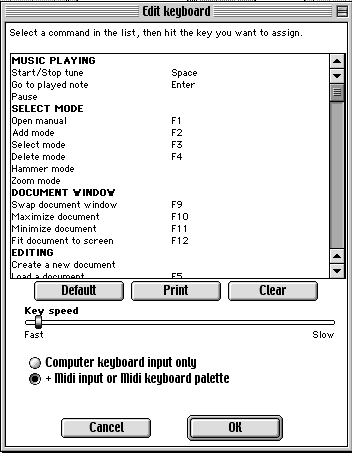
|
|
Edit keyboard
|
Once you have your staves on the screen, you can then
begin entering your score using all of the tools and
palettes Melody Assistant makes available to you. You
can place the notes one at a time on the staff using the
mouse. You may use the mouse to select the notes using the
on-screen keyboard. You may also define the keys on your
computer keyboard to place notes on the staff or to do any
number of other actions within the program (See Edit
Keyboard.pict). The problem with using the computer keyboard
is that the notes do not sound when you press the key. If
you use the on-screen keyboard and mouse, however, the notes
do sound.
You can set up your computer to accept input from MIDI
(Musical Instrument Digital Interface) devices. Melody
Assistant uses the Open Music System (OMS) from Opcode
to interface with MIDI devices. Since I now have a PowerMac
G4 which has no serial port, I have not been able to connect
my MIDI keyboard to my Mac. I spotted a hardware interface
in a catalog, but haven't bought that yet. So I haven't been
able to fully test the MIDI capability of Melody
Assistant.
You can also bring music in from a wide variety of
computer application formats. These include .aiff, .wav,
mp3, and even a Mac sound resource. All of these types are
brought in as digital sound files. That is, they are not
translated into notes on a staff. You can, however, combine
this digital input with written music in a score to create
your total musical experience.
On the other hand, with other types of formats the
attempt is made to translate the music into notes on staves.
These include Stand-alone (*.mux), MIDI (*.mid), Karaoke
(*.kar), Creative Music File (*.cmf), Band-in-a-Box (*.sty),
MOD (*.mod), S3M (*.s3m), Tab Text (*.txt, *.tab), OMeR
File(*.msf), ABC (*.abc), and Backup copy (*.bak). I was
only able to test the MIDI and MOD formats since I had
earlier acquired music in these formats. It was amazing to
see the notes appear on the staves for music that I had only
been able to listen to before. The interpretation done by
the program was not accurate. But it is like scanning a
document into a word processor. You have to do a lot of
editing to get it to spell and format everything correctly.
For example, with one song I imported, the melody was
written on the staff for the second piano and the bass line
was written on the first piano staff. I did not try to take
the time to figure out how to correct this "problem".
Saving Your Music
Music saved in Melody Assistant is saved as a
*.mus file. But music can also be exported as Stand-alone
(*.mux), MIDI 0 (*.mid), MIDI 1 (*.mid), Karaoke (*.kar),
Tab Text (*.tab), Creative Music File (*.cmf), ABC (*.abc),
Brut (*.brt), AIFF (*.aif), WAV (*.wav), and MPEG (*.mp3),
and a Macintosh Resource.
What this means, of course, is that you can use this
program to record your music from almost any source,
including the microphone input on your Mac, and save it as
an MP3 file. Thus you can even use this program to preserve
your old vinyl records and 8-track tapes. Of course, this
takes some memory resources, but that is to be expected with
digital audio. For example, I recorded 1 minute and 19
seconds of a song off of a cassette. It consumed 19MB of
RAM, and when saved to disk in native Melody
Assistant format (.mus), it took 12.8 MB of disk space.
When Melody Assistant converted it to the MP3 format,
the same snippet of music took 1.2 MB on disk. If you have a
CD recorder, you will want to save your music as AIFF files
and then use a program like Toast to create your own audio
CD's. The possibilities are endless.
The User Manual
|
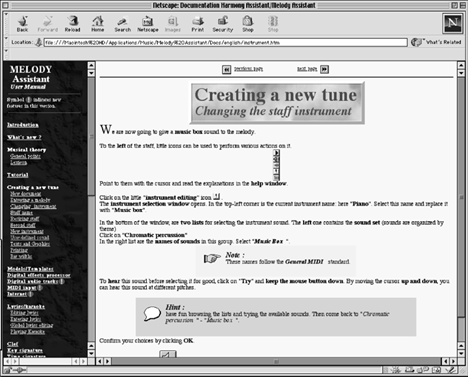
|
|
User manual
|
The User Manual is done in hypertext markup language,
which means that you use it within an Internet browser. This
makes it very user-friendly. Double click on the file
index.htm. The manual opens up in your default browser.
Double click on the flag for the language you chose when you
installed the program, English, French, German, Spanish,
Italian, or Japanese, and you are ready to go. The table of
contents appears in a frame on the left, and the manual
appears in the right-hand frame. Throughout the manual there
are hyperlinks so you can move quickly within the
documentation. (See User Manual Image.pict)
The major topics in the manual include the Introduction,
a What's New, a section on musical theory and a very
complete lexicon. The manual includes a tutorial,
information about the models / templates that come with the
program, information on the digital effects processor, how
to work with digital audio tracks, working with MIDI, how to
use the vendor's resources on the Internet, how to work with
lyrics within the program, how to use the Karaoke features.
There is a How To section, a FAQ section, and two
appendices, one dealing with using Melody Assistant
with the Yamaha S-YXG50, the other explaining how to
make an audio CD. Finally, there is the index, in which
every single reference is hyperlinked back to the manual. If
you ever have the need, a printable version is also provided
for printing from within your browser.
The Tools
There are a total of 17 palettes of tools. In the latest
version, there is an 18th palette, a master palette which
lists all of the other palettes and windows you can place on
your desktop. Using the master palette, you don't have to
keep all of the other palettes open in order to select a
tool from a particular palette.
|
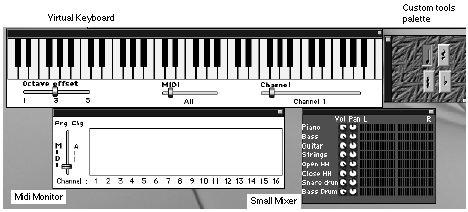
|
|
Keyboard2
|
In addition, there are 5 windows that can be accessed
from the master palette or under Windows on the menu bar.
The windows include a custom palette. Here you can place all
of the individual tools you want to use most frequently. You
can also have a full-size mixer, a small mixer, the virtual
keyboard, and a MIDI monitor. (See Keyboard2.pict)
All of the palettes are floating palettes. You can put
them anywhere on the desktop your heart desires. You can
have as many open or as few as you like. On all except the
master pallet, you can double click on the blue end bar, and
the palette will switch from vertical to horizontal or vice
versa.
|
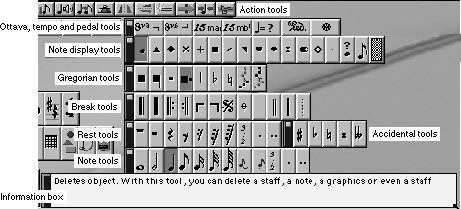
|
|
Tools & palettes2
|
Then there is the information box. No matter where you
are on the screen or what you are doing, the information box
provides information about the item you are rolling over or
pointing at with your mouse. This is an extremely helpful
feature when you are learning the program. (See tools &
palettes2.pict)
|
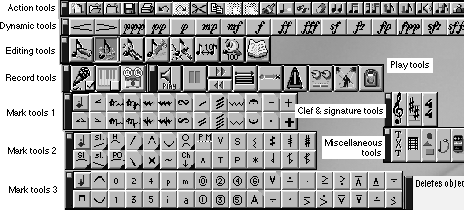
|
|
Tools2
|
The 3 mark tool palettes contain an amazing variety of
tools to create a large number of effects including trills,
tremolo, slurs, etc. If there is a purple corner on the tool
icon button, it has an effect on what is played. If it has a
blue corner, it applies to tablatures. Otherwise it is
placed on the score for information. All of the dynamic
tools affect how loud the music is played. (See tools2.pict)
The Staff
I could not take the time to calculate the number of
instruments available to the program. Just for example,
there are 11 different types of pianos including three
regular pianos, two electric pianos, a honkytonk piano, a
harpsichord and a clavichord. You can assign one staff to
each instrument, you can have multi-voiced staves, or you
can even establish rules such that a triangle-shaped note
will be a piano, but a diamond-shaped note will be a
trumpet.
|
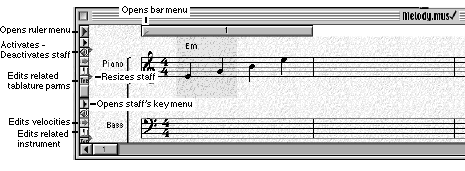
|
|
Staff2
|
At the left-hand end of the staff are tiny icons which
open powerful menus or windows. (See staff2.pict) An example
is the icon for opening the staff's key menu. By "key" is
meant "important." This menu consists of two columns of
selections divided into 5 sections. The "edit related
instrument" icon opens a window to the program's synthesizer
where you can create all kinds of mischief in trying to
develop your own unique musical sounds. (See
synthesizer.pict ).
|
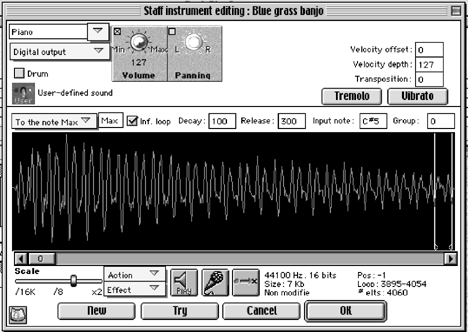
|
|
Synthesizer
|
There's More
|
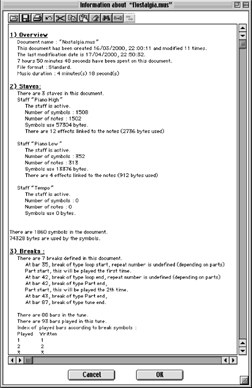
|
|
Doc info
|
While you are creating your masterpiece, Melody
Assistant is creating a record of its own, compiling
statistics about your creation. If you View Document Info...
under the File menu, you will see all the work that you and
the program have done. (See doc info.pict).
|
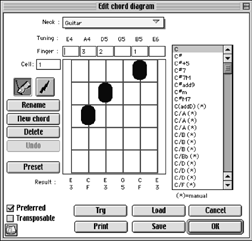
|
|
Edit chord
|
The program is very friendly if you play a fretted
instrument of any kind including cellos, lutes, ukeleles, or
guitars. (You can even define your own fretted instrument.)
Through the use of tablature, you can show on your score how
your selected instrument should be fingered. And since there
is more than one way to play the same chord, the Edit Chord
Diagram window allows you to specify how the chord is
played. (See edit chord.pict).
Melody Assistant has a jukebox feature that allows
you to develop lists of music which can be played in
whatever order you set, including a random order. The
jukebox allows you to automatically create an html file
which can be posted on the Internet or run from a browser.
|
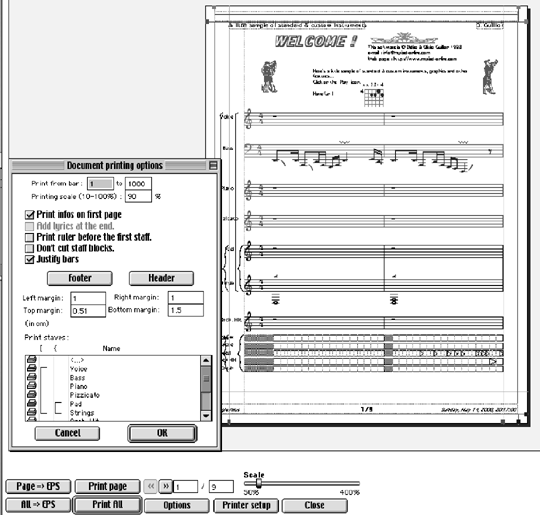
|
|
Printing4
|
Finally, to end my brief overview of the program,
printing is extremely flexible and capable. If your music
appears on music staves, you can print your music. Melody
Assistant allows you to position all of the elements of
your score on the page so you get a very nice-looking
printout. The print preview allows you to make adjustments
to the margins, adjust the scale of the image, create
headers and footers, decide how to print instrument
identifications next to the staves, decide which staves to
print, etc. Then you can print to an EPS file or to your
printer. (See printing4.pict).
How You Get It
I think you can tell from the tone of this review, that I
am extremely excited about this program. I expect to have
lots of fun with it for a very long time. I have placed my
first completed effort on the WAP TCS. The name of the file
is nostalgia.mp3.sit. This is a song by Yanni that I entered
into Melody Assistant from some sheet music for piano
that I happen to have and saved as an MP3 file.
Melody Assistant is currently up to version 5.1.1
and is available for download from Myriad at
http://www.myriad-online.com. It runs on Macintosh (Mac/OS
7.5 to Mac/OS 9, 68020+ or PPC) and Windows (95,98,2000 or
NT4). Again, it is only $18 if paid through Kagi. It's $15
if paid directly to Myriad.
E-mail support is free for all users (registered or not),
but infers you are using the most recent version of the
software. You may contact Myriad by sending an e-mail
directly from the program. You can contact other users on :
http://www.myriad-online.com/bbs
The company has several other offerings besides Melody
Assistant. Harmony Assistant is Melody's big brother. On
top of all the Melody options, it brings harmonizing, drum
sequences and other MIDI input capabilities. It costs $65
OMeR allows you to scan a musical
score into your computer and then converts it into music
you can hear, modify and print with Melody
Assistant or Harmony Assistant. OMeR can be run
as an independent program, but you'll need Melody or Harmony
to view documents generated by it. OMeR's cost is $15.
For a sample MP3 file created with Melody
Assistant, see the Pi's Web site at
http://www.wap.org/journal/melodyassistant/nostalgia.mp3
|














![]()